Woburn Sands Post Office
The British Post Office system dates back to 1660 when it was established by Charles II. Under the guise of the General Post Office, it soon grew as an important organisation, integral within the infrastructure of the country. Uniformed postmen took to the streets for the first time in 1793. In 1829, the first purpose-built mail facility at St. Martin’s Le Grand, London, was opened. Designed by Sir Robert Smirke, it was 400ft long by 80ft deep. Then Sir Rowland Hill came up with the idea of an adhesive postage stamp in 1837. These advancements and streamlining of their systems brought the postal service within the reach of even the poorest and the Post Office had a virtual monopoly on delivering written or printed communications. But there needed to be local representatives everywhere to handle the mail distribution.
The following is what I can find about the Woburn Sands Post Office. Unlike pub histories, there were no licencing sessions or drunken fights that made the local newspapers, so stories about the Post Office are few and far between, but there are a few. Also unlike pubs, the Post Office has never had to advertise for business!
Once the Post Office network had been set up, there were large branches locally in Newport Pagnell for Bucks. and Woburn in Beds. Gradually, this developed until every small village had someone responsible for receiving mail from outside the area and gathering all the local out-going mail. These people were described in the various Trade Directories of the time, such as Kellys in 1839 for Woburn:
“POST-OFFICE, Bedford-street, WOBURN, Stephen Dodd, Post Master. Letters from LONDON arrive every night at half-past twelve, and are despatched every morning at two. Letters from BEDFORD arrive (by mail cart) every night at a quarter-past eleven, and are despatched every morning at four.”
…and the Kellys of 1847, listing Wavendon and Woburn Sands although no postmaster was listed for the latter:
“WAVENDON Post Office – Samuel King, postmaster. Letters are received through the post office, Newport Pagnell, arrive 9 morn.; dispatched half past 5 evening. HOGSTY END or WOBURN SANDS – Letters are received through the Newport Pagnell office at 9 morn; dispatched half past 5 evening.”

Undoubtedly, this would have been a local trader who took on the job of collecting and distributing the post locally – it wasn’t then a full-time position. Mr. King continued at Wavendon until at least the late 1860s.
Ken Smith’s “UK Post Offices by County” postal history database gives an earliest-known date for Woburn Sands Post Office as 6th April 1858. This was the date they proofed a circular postmark for backstamping mail passing through the Woburn Sands Post Office, as discovered at the Post Office Archives. Presumably, the stamp would then have been sent to the office for use within a short period, although there is a possibility that the office did not open then, and the stamp was never in fact used.
If it did open at that time, this pre-dates the first name of an individual we have of running a Post Office here, which was in connection with no.1, Aspley Hill. That area of Woburn Sands was then known as “Cheapside”, where most of the tradesmen’s premises were situated before the High Street was developed.
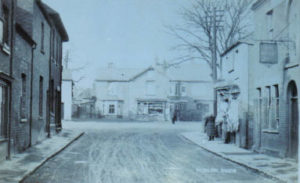
Late local historian Arthur Parker researched local properties and examined any deeds he could. His notes record that no.1 Aspley Hill had originally been owned by a William Randall of Husborne Crawley, a butcher. He sold up in March 1859 to Thomas Hudson, described as a shopkeeper, who was a grocer and butcher. The Hudson family appear on the first census with individuals details list on, that of 1841, listed under Hogstye End in Wavendon. Thomas’ father James had been an agricultural labourer, so Thomas had done well to get himself a trade and his own business. He was certainly acting as ‘Post Receiver’ by 1864, but whether he had been doing so in 1858 at a previous address, or if he was already a tenant in no.1 Aspley Hill before buying it is unknown. He also bought adjoining property and various other pieces of land.
He is listed in the 1861 Census, with an unspecified Woburn Sands address, as:
Thomas Hudson, 31, Butcher & grocer, born Wavendon
Eunice Hudson, wife, 34, Dressmaker, Woburn
Sarah Ann Hudson, daughter, 6, Aspley
Emily Edith Hudson, daughter, 4, Aspley
Henry Montague Hudson, son, 2, Aspley
Frances Ada Hudson, daughter, 1, Aspley
But what of the Post Office business? Hudson was first listed as a “Receiver” in the Kellys Trade Directories of 1864 and 1869 for Woburn Sands:
“POST OFFICE – Thomas Hudson, receiver. Letters arrive from Woburn at 6.45a.m.; dispatched at 5.35p.m. & on Sundays at 10.30a.m. Woburn is the nearest money order office & post office savings bank.”
Hudson had to cope with enormous changes in what services the Post Office provided. From being simply a receiver and distributer of letters, the network became an ideal base for all sorts of administrative and financial services in a short space of time. His postal work would certainly take up a good deal of space in his small butchers shop. Communication was now within the reach of all levels of society, not just the rich. The Leighton Buzzard Observer of 10th August 1869 ran a long editorial on the current state of the Post Office nationally, which contains some interesting figures:
“This vast establishment, which for many years following its origin was devoted exclusively to the conveyance and delivery of letters, has grown so enormously in function as well as magnitude that its title is no longer strictly correct. Instead of being merely post office, it is devoted, in addition, to the purposes of banking, life insurance, parcels transmission, shipping, and tax-gathering. As if these are not sufficient duties to engage its strength, it is now about to assume the further business of managing the telegraphic system of the country. Probably the last-mentioned will not constitute the final task thrown upon it, for its ramifications and countless local offices render it admirably adapted for the performance of any service which involves communication with the masses of the people. In England, Scotland, and Ireland, collectively, there are the present time just upon 18,000 places for the reception of letters, being at the average rate of one for every 330 houses throughout the kingdom.
Among them these offices collect, transmit, and deliver upwards of 800,000,000 letters and 100,000,000 newspapers and book or pattern parcels a year; they hold nearly £12,000,000 of savings’ bank deposits, belonging to nearly 1,000,000 individual depositors; they are responsible to nearly 2000 policy-holders for life insurances, amounting, in the whole, in addition annuities, to about £150,000; their money order transactions amount to 19,000,000 a year; and they issue annual dog licenses to nearly 400,000 persons. All this variety and extent of work performed with so much efficiency and regularity that a complaint is very rarely heard, even in this complaining age, as to any portion of the multitudinous operations.
The results are attained with a precision which is scarcely equalled in any other kind of business, the principal and almost sole cause of irregularity being traceable to the carelessness of the people. During last year only a trifle less than 14,000 letters were posted without any address whatever, about 300 of them containing money, which in the aggregate amounted to considerably more than £6000. This is only one instance of the negligence displayed by the clients the office, for far greater number of superscriptions must have been either illegible or unintelligible, or addressed to places that no one could find. When we consider that these thousands of mistakes were made by persons who had each only to deal with his own communication, our admiration is the more excited at the freedom from error of a gigantic establishment comprehending in its scope the intercommunication of great empire with its colonies and foreign relations.”
The 1871 Census recorded the following occupants of the house, listed under “Woburn Sands”:
Thomas Hudson, 41, Butcher and Grocer, born Wavendon
Eunice Hudson, wife, 44, Grocers wife, Woburn
Sarah A. Hudson, daughter, 15, Straw bonnet sewer
Emily E. Hudson, daughter, 14, scholar
Lydia Hudson, daughter, 11, scholar
John Hudson, son, 9, scholar
Alfred E. Hudson, son, 7, scholar
Margaret Hudson, daughter, 2, scholar
Alvery Hudson, son, 7, scholar
All their children were born in Woburn Sands. Children usually appear strictly in age-order on the census; I wonder if Hudson forgot one until the last minute when detailing his to the enumerator! The Hudson’s had 13 children in all, but some died in infancy. His wife Eunice died in 1872, but he later remarried. As well as his butchers and Post Office businesses, Hudson also had some property to rent out. This was not without its complications… From the Northampton Mercury of 13th March 1875:
“Woburn Sands – Hudson v. Coombs. Thomas Hudson, postmaster, of Woburn Sands, brought an action in the Leighton County Court, on Thursday, against the Misses Sophia and Mary Coombs, now resident at Lidlington, to recover the sum of £2 4s. 6d., as compensation for loss and injury alleged to have been sustained by reasons of defendants leaving a house belonging to him. His Honour said the conduct of the plaintiff was inexplicable and harassing, and he gave judgement for the defendants with costs, Mr Willis, of Leighton, for the plaintiff; Mr Stimpson, of Bedford, for the defendants.”
As well as the variety of services that the Post Office offered increasing, the local neighbourhood was expanding rapidly. New side streets were being laid out in the local villages all the time. Although Wavendon and Aspley Guise each had their own Post Offices at this time, some people were still not happy with the local service.
In the autumn of 1875, a parish meeting was organised in Aspley Guise and Woburn Sands to campaign for a second delivery daily. It was decided to send a petition to the Postmaster-General. Messrs. Dymond and Kemp canvassed Aspley Guise for signatures and Mr. Denison and Mr. Down covered Woburn Sands. The report in the Bedfordshire Mercury of 2nd October mentions that Aspley Guise and Woburn Sands offices were sub-offices to Woburn. This meant any mail arriving by rail during the day travelled through Woburn Sands to go to Woburn, where it was held until being dispatched back to Woburn Sands or Aspley Guise the next day. The sub-offices also closed at 5.30pm, but mail was not dispatched from Woburn for Woburn Sands station until much later, leading to delays. The next month, Rev. S. H. Gem of Aspley Guise, chairman of the committee appointed to prepare the petition, had received a reply:
“Sir, – With reference to the memorial from the inhabitants of Aspley Guise and Woburn Sands, received at this office on the 9th ultimo, I beg leave inform you that an arrangement has been sanctioned for affording a later despatch of the night mail from Aspley Guise and Woburn Sands, by means the train leaving Woburn Sands Station at 8.27p.m., and that authority has also been given for the establishment of a day mail despatch to those places. The day mail will be due at Woburn Sands Post Office at 10.40a.m., and the Aspley Guise Post Office at 11a.m., and the letters may be obtained shortly afterwards by application at those offices. I am, sir, your obedient servant, A. Benthall.”
When the next Kellys was published in 1877, the new arrangements were detailed:
“Woburn Sands. Post & money order office & Savings Bank, Woburn Sands. – Thomas Hudson, receiver. Letters arrive from Woburn at 6.45 & 10.55, a.m.; dispatched at 5.40 & 7.55 p.m. & on Sundays at 12 noon.”
In the 1881 Census, the Hudson household appeared listed between “Goodmans House” and properties on Hardwick Road, but it is specified as “Post Office” for the first time:
Thomas Hudson, 49, Butcher and Grocer, born Woburn Sands
Mary A. Hudson, 50, Stewkley, Buckingham
John T. Hudson, son, unmarried, 20, butcher
Alfred E. Hudson, son, 14, scholar
Margaret Hudson, daughter, 12, scholar
Eldest son John was the local organist at St. Michael’s, although how good his playing was is open to debate, given this exchange which appeared in the Leighton Buzzard Observer in October 1882:
“WOBURN SANDS. THE HARVEST FESTIVAL. Sir, – On reading the account of the harvest festival lately held at Woburn Sands I wish to call attention to a slight error. It stated that the Rev. M. B. Nepean presided at the organ. It should have been that he (Mr. Nepean) intoned the service, which was full choral. I asked him myself to play the last hymn, and so conclude the service, but the earlier musical portion of the service was rendered by – Yours faithfully, John Thomas Hudson, organist of St. Michael’s church, Woburn Sands.”
“WOBURN SANDS HARVEST FESTIVAL. Sir, – Noticing a letter in your last issue from Mr. John Thomas Hudson under the above heading, I would like to correct the statement he makes in it. He states that the account published of the festival stated that “the Rev M. B. Nepean presided at the organ.” Having written the account myself, I beg to say it stated no such thing, but that the rev. gentleman intoned the service, playing the last hymn, also a selection of music at the close of the service. I do not doubt the statement to give his own words, “I asked him myself to play the last hymn,” or that “the earlier musical portion of the service was rendered by” him. I should not have cared to insult the Rev. M. B. Nepean by contributing that portion of the service to one of his known ability. It was in merciful consideration for Mr Hudson that his name in connexion with the organ was omitted. I am, sir, faithfully yours, The Correspondent.”
The 1885 Kellys Directory had much the same entry as the last one had, but with the additional information that “The nearest telegraph office is Aspley Guise.”
Within just over a year from February 1885, both of Hudson’s sons were married – second son Alwyn to Julia, eldest daughter of George Tansley, at the Baptist Chapel in Ridgmount; and then eldest son John Thomas to Mary Jane Hines, daughter of Mr. Hines of The Talbot Inn at Loughton in March 1886 at Loughton Church. Perhaps it was his family (and therefore assistants) moving out, or perhaps as it had grown and become more complicated, Hudson decided to relinquish the Post Office business in 1888 and so sold or transferred it to Mr. John Pikesley in 1888.
[Thomas Hudson eventually died in September 1916 and was buried at St Michael’s. He left £24,000, with £100 legacies to each to his seven grandchildren. (Ella Summerley’s family history notes – available on this website) His remaining estate was offered by auction [Beds Archives: HN7/2/WS6] and No.1 Aspley Hill with the butcher’s business was purchased by Walter Pratt, who came from Dunstable, who had already been tenant there for many years since Hudson had retired. Pratt’s son continued the business until 1964 and it remained in the butcher’s trade until Pete Lowe moved his business around to the High Street the late 1980s.]
Pikesley had married a local girl, Mary Ann Emerton, in 1876 and they were living in Chapel Street at the time of the 1881 census with one son, John junr. John senr. decided he needed a purpose-built property for his new venture. He was also a carpenter and funeral director, so a spacious and modern building with outbuildings would be required. Parker’s research notes again, for Woburn Sands High Street no.29:
“When Giles laid out Vicarage Street, he had already got a customer in John Pikesley, for in December 1888 (that is the date on the conveyance) he sold the corner plot for £145. His purchaser, Pikesley, being described as “postmaster”. He was officially appointed to that office on 26th January 1888, and the post office was built in the summer of that year, for he took a mortgage of £250 on it in September. John Pikesley was a carpenter and undertaker by trade, and he carried on his undertaking business premises at the rear… Pikesley had, however, only built on half of the plot he purchased, and on the same day as he completed his purchase, he sold (for £75) the other half to George Willison, who had a confectionery business at Aspley Guise and a branch at Wolverton. Willison built his “Providence House”, and Mr. Bathurst (incumbent Woburn Sands chemist at no.31 when Parker was writing his notes) has told me there still remains on the premises marks of his religious character.”
The erection of a new Post Office for Woburn Sands did not go unnoticed. When built, it had a corner door which also overlooked Vicarage Street. The Northampton Mercury, of 6th October 1888:
“WOBURN SANDS. THE POST-OFFICE. Mr. John Pikesley, the newly-appointed postmaster, has quickly overcome the difficulty of finding suitable premises. He has, as if by magic, reared a spacious new building in the best position of the district, presenting a graceful appearance, and providing ample room for the transaction of the rapidly growing postal and telegraphic business.”
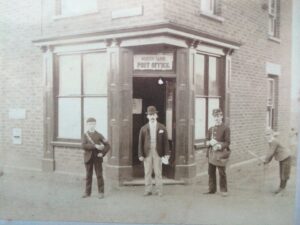
So… Woburn Sands finally had an appointed “Postmaster”, rather than just a “Receiver”. But it appears he was only a “Sub-Postmaster”, as indicated by the next Kellys of 1890:
“Post, M.O. [Money Orders] & T.O. [Telegraphic Office], S.B. [Savings Bank] & Annuity & Insurance Office, Woburn Sands – John Pikesley, sub-postmaster. Letters arrive from Woburn at 6.40a.m. & from Bletchley direct at 11.50am. & 4.45 p.m.; dispatched at 12.30 & 7.55p.m. to Bletchley direct & 6p.m. to Woburn; & on Sundays at 12 noon. WALL LETTER Box, Station road, cleared at 11.40am. 4.30 & 7.40p.m.; Sundays 12 noon. WALL LETTER Box, Aspley Heath, cleared at 11.20a.m. 4.10 & 7.25p.m.; Sundays 11.45a.m.”
Under the general directory entries, John Pikesley was listed as a stationer and Post Office. The 1891 Census for Woburn Sands “High Street Post Office” gives us some details of the Pikesley family:
John Pikesley, 36, Postmaster and Stationer, born Gayhurst, Bucks
Mary Ann Pikesley, wife , 40, Aspley Guise
John Pikesley, son, 13, scholar, Wavendon
Herbert Fred Pikesley, son, 7, scholar, Wavendon
Sydney James Clarke, lodger, single, 23, Maltmaker, Smethwick, Birmingham
As well as the post box collection times, the 1898 Kellys gave an ever-increasing list of services. “Post, M.O. [Money Orders] & T.O. [Telegraphic Office], T. M. O. [Transit Mail Office], S. B. [Savings Bank], Express Delivery; Parcel Post & Annuity & Insurance Office.”
The 1901 Census for Woburn Sands High Street shows that Pikesley’s sons had now joined him in business:
John Pikesley, 48, Postmaster, born Gayhurst, Bucks
Mary Ann Pikesley, wife, 50, Aspley Heath
John Pikesley, son, 23, Post Office Assistant, Wavendon
Herbert Fred Pikesley, son, single, 17, Carpenter and Joiner, Wavendon
Alice Fanny Collins, servant, single, 28, Post Office Assistant, Aspley Guise
(Alice Collins also issued local postcards once she had her own stationers shop in the High Street later.)
A report in a Leighton Buzzard Observer of 2nd March 1904 said that plans for alterations to his premises in the High Street, Woburn Sands, had been submitted by Mr. Pikesley, but they were not approved. He resubmitted them in May and they were then approved successfully. I wonder if this was when the corner entrance door, evident in the early photograph, was taken out?
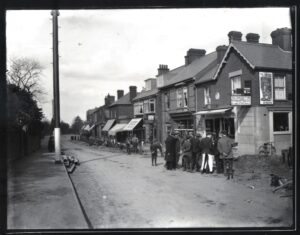
In May 1910, John Pikesley Junr. was appointed as a Parish Overseer, a position that collected the various rates levied locally, as decided by the Council, an appointment that would lead to serious repercussions for the Pikesley family. John junr. was obviously considered a competent administrator; he was clerk to Woburn Sands Parish Council from 1910. (John senr. had stood in the first election to be a councillor when Woburn Sands Parish was separated from Wavendon in 1907, but he didn’t get enough votes.) John junr. was then appointed as the enumerator for the 1911 Census for Woburn Sands. Therefore, he was responsible for gathering the details of his own family! Listed under “Post Office” was:
John Pikesley, 58, Postmaster, Carpenter, Joiner and Undertaker, born Gayhurst, Bucks
Mary Ann Pikesley, wife, 60, Assisting in Business, Aspley Heath
Herbert Fred Pikesley, son, single, 27, Motor & Cycle Repairer, Woburn Sands
Alice Fanny Collins, assistant, single, 38, Post Office Assistant, Aspley Heath
Pikesley commissioned many, many postcard views of the local villages to be sold in his shop, cashing in on the hundreds of tourists coming to area to walk in the woods and breathe the (allegedly) healthy airs. These were generally produced by photographer Harold Camburn of Worthing. He travelled the country taking attractive real photographic images under contracts for local shops and Post Offices. I have seen more than 50 examples with Pikesley’s details on.
1913 got underway with a pleasant celebration at the Post Office of a “presentation to postman Mr. T. Garrett on the occasion of his marriage. Mr. Pikesley made the presentation, which was in the form of a bronze hanging lamp and an illuminated address.” (Luton Times & Advertiser, 31st January 1913). Yet by the summer, his son John junr. was in a lot of trouble…
It had come to light at Newport Pagnell Board of Guardians after a complaint from the Local Government Board that John junr. had collected more than £140 in local Poor and Sanitary Rates from parishioners, but not deposited the money into the Board’s account. Indeed, he had submitted reports stating he was holding no monies himself and payments that he had made were 2-3 months late. John junr. submitted a letter explaining he had been very busy working at Wilson’s Motors in Woburn and had not had time to make up the accounts and disputed the auditor’s report. “After a little discussion, the following resolution was passed; ‘That the Chairman should severely reprimand Mr. Pikesley for his gross carelessness.’ Mr. Pikesley was again called into the room, and the Chairman informed him of the resolution which had been passed. In future, all money that was received on behalf of the overseers must be paid into the overseers’ account. His written explanation and a copy of the resolution would be sent to the Local Government Board.” (North Bucks Times & County Observer, 14th June 1913)
However contrite John junr. had appeared to be and convincing in his explanation, it obviously didn’t settle the matter. Someone came forward with new evidence of wrong-doing and the case was reopened. The Northampton Mercury, 11th July:
“The Board [of Guardians, Newport Pagnell] resolved to forthwith suspend Mr. Pikesley, the Woburn Sands collector, who is at present under remand on a charge of fraud, and that it will be left with the clerk to make the best arrangements possible in the matter of the rate books, etc., and, if absolutely necessary, to employ temporary help in making them.”
The North Bucks Times reported that a sensation had been caused by John junr.’s arrest. The charge was Obtaining Money by False Pretences. It was alleged he had issued an additional rate on the inhabitants of Woburn Sands and had kept a double set of books to try to disguise it. The specially-printed Rate receipt books were printed locally by the Woburn Sands printer, Edward Miller, who gave evidence that Pikesley had had two sets of books from him, claiming the first set had contained a mistake. He used the first set to collect £8 6s. from a Mr. Tarver, before the rate had actually been issued. No defence was entered at the hearing but the Magistrate decided to settle the matter immediately and acquitted Pikesley on grounds of “no evidence of fraud, only laxity”. This brought “great joy to his many friends in the Court”.
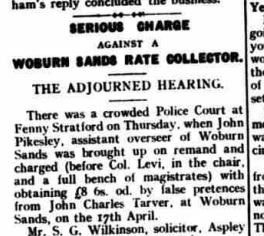
For four months, the Board of Guardians and the Local Government Board tried to find out exactly what he had done. Newspaper reports talked of their displeasure at his “fragrant disobedience of the injunction” brought in June. He had paid back more than £150 of the money and according to the Board’s auditor, £13 was actually owed to Pikesley! The money so held was earmarked to pay for the auditor’s services. The Public Prosecutor gathered new evidence against Pikesley and decided in November 1913 that if any charges were to be brought, they ought to be done so by the Newport Pagnell Board themselves. They did so and a Warrant was issued for his arrest again.
But where was John junr.? Having been released by the Court in July, John Pikesely junr. had promptly disappeared! The Police Gazette listed him under “WANTED” on 7th November 1913, from which we find the probable cause of his downfall:
“Newport Pagnell (County) for converting £60 12s. 6d. to his own use at Woburn Sands, 10th May last, also £20 on 28th May last. John Pikesley, age 32, height 5ft. 6ins., complexion pale, thin face, hair, moustache and eyes brown; addicted to drink and gambling; dress, blue surge suit, bowler hat, lace boots. A native of Woburn Sands, Bucks. Was employed as rate collector formerly a Post Office clerk, will probably leave the country. Warrant issued. Not to be arrested out of the United Kingdom. Information to Superintendent Pearce, Newport Pagnell.”
They would look in vain, as within two weeks of his first acquittal in July, John Pikesley junr. had boarded the White Star ship, the “Olympic”, at Southampton and gone to New York on 23rd July! He travelled second class and alone, without his wife and two children. He must still have been in touch with his family as his wife Alice and their boys, Frederick and Richard, also boarded the “Olympic” to New York in October 1914. They settled in ST. Louis, Missouri. John Jnr. stayed there for the rest of his days, under his own name it would seem, working his way up to being Chief Payroll Clerk with the Steam Railway. He took American Citizenship in 1920, adopted two further children and eventually died on 9th November 1957. He is buried in Valhalla Cemetery, St. Louis County, Missouri. A case file about the crime survives at Buckinghamshire Archives at Aylesbury [DC_3/4/5]
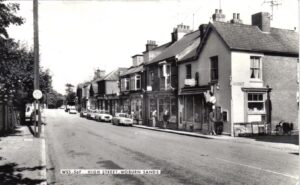
Back in Woburn Sands, John senr. stayed on as the sub-postmaster despite the scandal, although he withdrew as Woburn Sands’ representative on the Rural Council at this time and after eight months’ absence, they decided to replace him. I imagine there were some awkward conversations in the Post Office about the affair! The fact that the Great War then started probably took local minds off the missing Overseer and their money. His other son, Herbert Fred, went on to become the Woburn Sands’ mechanic and opened his own garage in the High Street, which still bears his name but has no connection to the Pikesley family now. The war also made a dramatic difference to the trade directory entries. This from the 1914 Kellys:
“Post, M.O. & T. & Telephonic Express Delivery Office, Woburn Sands (letters should have Beds added). John Pikesley, sub-postmaster. Letters arrive at 4.15 a.m. & 12.10 & 4.45 p.m.; delivered at 7 & 10.30 p.m. & 12.35 & 5 p.m.; dispatched at 10.15 a.m. & 2.20, 3, 5.45, 8 & 10 p.m.; parcel mail. 10.15 a.m. & 12.15, 3, 5.45 & 8 p.m.; Sundays, office open from 8.30 to 10 a.m.; the box is cleared at 7.25 p.m. Wall Letter Boxes.- North End, cleared at 7.35 a.m. & 12.5, 1 & 7.40 p.m.; Sundays, 11.40 a.m.; Aspley Heath (near church), cleared at 10 a.m. & 1 & 7.25 p.m.; Sundays, 5 p.m.; Church wall, cleared at 10.5 a.m. & 1 & 7.25 p.m.; Sundays, 5 p.m.; Daneswood cleared 8 a.m. & 1.5 & 7.20 p.m.; Sunday, 4.50 p.m.; The Leys, cleared at 10 a.m. & 1.30 & 7.30 p.m.; Theydon Avenue, cleared 10.15 a.m. & 1.15 & 7.40 p.m. Sunday, 5.15 p.m.”
…then this much shortened version from after the War, the 1920 Kellys:
“Post, M.O. & T. & T.E.D. Office, Woburn Sands (letters should have Beds added) – John Pikesley, sub-postmaster. Wall Letter Boxes. North End; Church wall; Daneswood; Sinfield Terrace & Station Road.”

Parker states that it was ill-health that finally forced John Pikesley to give up his various businesses. The undertaker role was given up first and passed to his nephew Edgar Smith, who transferred it to premises in Hardwick Road. Pikesley continued as Postmaster until another nephew, Alfred John Holmes, took over in c.1922 (when he first appears in the Register of Electors in Woburn Sands High Street). Holmes’ sister, Alice, ran the Post Office in Aspley Guise – quite a family business.
John Pikesley snr. eventually died in 1928. He left £877 to his widow. From the Bedfordshire Times, 27th April:
“Mr. John Pikesley, of High Street, died early on the 19th of April. Deceased was 75 years of age, and for the past nine years had been a sufferer from paralysis. Mr. Pikesley was for very many years the village postmaster, resigning in consequence of illhealth. At the same time he relinquished the business of carpenter and undertaker, which he had successfully carried on during the greater part of his life. He was held in high esteem by those with whom he had come in contact. An ardent churchman, he was for many years warden at St Michael’s Church. At the inception of the local branch of the National Deposit Friendly Society, under the chairmanship of the late Rev. E. H. Mosse, then Vicar of the parish, Mr. Pikesley became the first district secretary.”
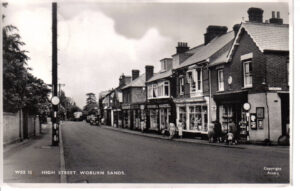
The periodic entries for the Post Office continued in the trade directories issued every 4-5 years. The 1924 entry had “Letters should have Beds. added”, but by 1928 this had changed to “Letters through Bletchley, Bucks.”. The 1939 Kellys was the first to feature a telephone number for the Post Office, “3101”.
Holmes, too, produced many postcards of the area from his shop, but not as many as his sister did at the Aspley Guise Post Office, who also commissioned postcards from her Post Office and always liked to be in them! Between them, I have seen more than 90 examples. The 1939 Register taken to produce war-time ID cards gives three residents of the Woburn Sands Post Office:
Alfred J. Holmes, 49, Sub-Postmaster
Charlotte A Holmes, 55, Unpaid Domestic Duties
John F. C. Holmes, 23, Carpenter
Parker states that a Wallace Swain took over from Holmes in 1948. Newspapers have far less local news in the second half of the 20th century and the Post Office appears in very few reports. A 1971 newspaper feature on Christmas shopping in Woburn Sands in the Beds & Bucks Reporter included a photo that shows the name “Manning” over the Post Office, then a c.1977 postcard has the name “Franklin’s” over the business. Local memory recalls a few other names, shown below.
In the 70s-80s, I can recall the massive (to me…) penny sweet counter, inside the door on the left, before it became gifts, stationery and cards. The Post Office continues to be a vital asset to the town today, providing financial and communication services.
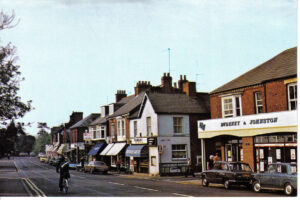
Post Office, Woburn Sands
1859-1888 Thomas Hudson
1888-1920 John Pikesley
1922-1948 Alfred John Holmes
1948-???? Wallace Swain
1971 Manning
???? Manley
c.1977 A & M Franklin
c.1978 Moore
1986-1997 John & Sharon Allen
1997-1998 Val Morris
1998-2006 Tina & Sam Bhuva
2006-2007 Mr. Irfaan
2007-Now Tina Patel
Page last updated Dec. 2021.
